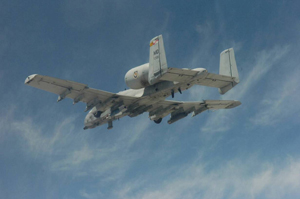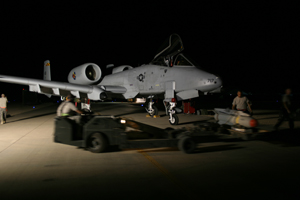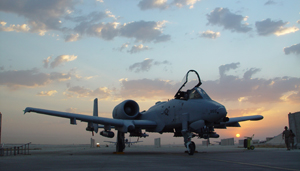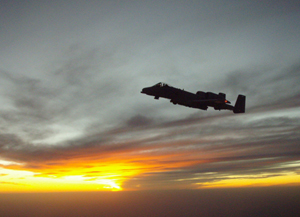Last fall, a new breed of A-10 went into combat for the first time. The Warthog in question was the newly upgraded A-10C, a variant of the venerable attack aircraft that has proved itself many times over in Iraq and Afghanistan.
The new A-10s first delivered weapons on Sept. 19, a day that was otherwise like any other in the fight on the streets of Iraq. US ground troops called for air support after discovering a house rigged with explosives in an urban area not far from Balad Air Base. The insurgent safe house was wired to explode when ground troops came knocking.
Troops were tense. The countrywide “surge” had begun earlier in the year, and soldiers were working “outside the wire” much more frequently, mixing with the population, ferreting out insurgents and weapons caches the hard way—door to door. The previous day, a patrol had kicked in a door in the neighborhood and set off an explosion—killing three US soldiers.
 |
Two A-10Cs of the Maryland ANG train in preparation for deployment to Southwest Asia. (Photo by Rick Llinares ) |
On Sept. 19, the joint terminal attack controller with the ground troops that day was in a similar situation. The booby-trapped house was ahead, and intelligence from locals indicated insurgents were lying in wait. The JTAC wasn’t about to let the bad guys get the upper hand, but needed to be careful—he didn’t want collateral damage to turn an easy win into a setback. A mosque was nearby as well.
A call for close air support was placed. Soon, a pair of jet aircraft from the 104th Expeditionary Fighter Squadron out of Al Asad Air Base was approaching. They were moving slowly, and they were quiet—not the loud rumble of F-16s that often showed up. Moments later, the insurgent house was reduced to rubble—courtesy of two satellite-guided Joint Direct Attack Munitions. The mosque next door received only a light dusting. The first combat strike for the A-10C was complete, and it was a success.
First created to loiter over European plains and chew up Soviet-armored columns with its fearsome 30 mm rotary cannon, the Warthog has been spared from retirement numerous times to become a sort of CAS rock star.
From the 1991 Gulf War, when Warthogs were the bane of Iraqi tank columns, to Afghanistan where A-10 pilots could loiter around the high mountain passes and valleys to wreak havoc on Taliban elements, the aircraft has shown remarkable effectiveness and toughness.
Lt. Col. Dan Marino, 175th Operations Group commander, recalled an earlier deployment to Afghanistan, “riding on the back of a tailgate … out to our jets at night [and] taking off from an old Russian air base to escort helicopters along the Pakistani border. We thought to ourselves, ‘If somebody had told us 17 years ago we would be doing this, we’d have thought they were out of their mind.’ “
The precision engagement upgrade to A-10C configuration only adds to the aircraft’s lethality. “This is the first major modification in 20 years,” said CMSgt. Terry M. Allen, the squadron superintendent for the 175th Aircraft Maintenance Squadron at Martin State Airport, near Baltimore. The 104th FS—attached to the Air National Guard’s 175th Wing—now has 17 A-10Cs, with more to come as a result of base realignment actions.
A veteran of the Iraq deployment, Allen accompanied the Maryland ANG’s transition to the A-10C from the beginning, volunteering to be the NCO in charge for the upgrade program as the unit sent a detachment out to Nellis AFB, Nev., to begin modifications in November 2005. The Air Guard was first to get upgraded aircraft, and work on the airplanes continued until the summer of 2007, shortly before the A-10s headed out on an unexpectedly complex deployment. “We were modding airplanes … in April that deployed in September,” Allen recalled.
By the summer of 2007, with the deployment to the sandbox looming, the PE line had cranked out enough aircraft to equip two squadrons with 17 airframes each—one in Michigan and one in Maryland.
Marino said the 104th had “one foot on the boat and one foot on the dock.” The As were leaving, the Cs were coming in, and even though the iron was back on the ramp, software upgrades and electrical issues were being worked out as the aircraft arrived.
The 104th was cleared to train with the JDAM in late summer; the data link was programmed in by the end of June, and the laser Maverick was integrated into the system architecture. “The main driver was getting the unit over to OIF in September,” Marino added.
 |
A Warthog in flight . (USAF photo by Andrea Erdekian) |
A Rainbow Unit
The Maryland ANG then deployed several of its newly modified Warthogs, as did the Michigan ANG’s 172nd FS from Battle Creek. They formed what is known as a “rainbowed unit”—a mix of airplanes from different units operating under the same expeditionary squadron.
When the aircraft and personnel arrived last September at Al Asad Air Base, they became the 104th Expeditionary Fighter Squadron. Despite the A-10’s near-constant presence in Afghanistan, this was the first time the fighters had deployed into Iraq since 2003.
The Thunderbolt IIs, in official parlance, were immediately put to work against one of the most persistent problems in theater—the proliferation of improvised explosive devices. We spent a lot of time searching for IEDs, said Lt. Col. Timothy Smith, commander of the 104th FS. Using the aircraft’s targeting pod to detect the bombs’ heat signatures, pilots would beam intelligence on IEDs down to ground troops. Many times, A-10s were called on to strike IED emplacements and caches of explosives uncovered during these sorties.
A-10s were also called upon to combat “trigger houses,” such as the one on their first sortie, Smith said. Often rigged with explosives, and with insurgents waiting close by in ambush, these buildings were some of the most dangerous places for ground troops to encounter.
The A-10C’s new precision capabilities were invaluable against these tactics. With its ability to loiter low to the ground and pack the punch of precision weapons, the A-10 now could operate better in the dense and dangerous urbanized areas of Iraq.
“With this munition, we’re able to pinpoint a building,” said Capt. Brian Curland, one of the 104th FS pilots who deployed to Iraq, referring to the JDAM. Collateral damage was minimized because the JDAM can be fused to bury itself into the building then detonate. “You’re looking at basically just taking the building out from the inside out instead of the outside in like before.”
Curland was one of the two pilots on the sortie who dropped the squadron’s first JDAMs in Iraq.
The new, flexible weapons load brought what squadron members called the “candy store effect” to close air support. This stood in stark contrast to the “Russian candy store” of weapons the A-10 used to offer—”I got a bomb or a bomb, what do you want?” quipped Marino.
Smith said the ability to switch back and forth between JDAMs and laser guided bombs was invaluable in Iraq, as the nature of threats and targets shifted constantly during the deployment.
“We tended to use the LGB when we didn’t need exact coordinates,” he recalled. During one sortie, coalition forces had been tailing insurgents who were cornered in a greenhouse-like building—long and rectangular. A Warthog lased the target and let loose a GBU-12.
 |
At Al Asad Air Base, weapons loaders move an AGM-65D Maverick missile onto the wing of an A-10C of the 104th Expeditionary Fighter Squadron. (USAF photo by MSgt. Ed Bard) |
More often than not, the Warthog’s weapon of choice—the seven-barrel GAU-8/A 30 mm gun—was called on for its high rate of fire and precise high-explosive incendiary rounds.
With friendly forces not far away, such as in convoy or patrol situations, the gun was a lifesaver, Marino said.
One of the last weapons equipped on the A-10Cs just prior to their deployment was the laser Maverick air-to-ground missile—the AGM-65E—which until last year was used primarily by the Navy and Marine Corps.
Today, the missile is being produced again for use on Air Force aircraft, but in late 2007 A-10s needed a quick fix for a problem in theater. Commanders needed a reliable weapon that could track and hit moving targets such as insurgent vehicles. While not employed many times during the OIF rotation—only two were fired—Lt. Col. Kevin Campbell, head of the 175th Maintenance Squadron, said the weapon proved successful and adaptable. The A-10 program office has decided to hold off on equipping the C model with the Hellfire missile because the laser Maverick showed so much promise.
Even the radios in the aircraft—there are three of them—work in a more consolidated manner now. Previously, a pilot had to do a lot of switching on his side panel between the three, which kept secure links with ground troops, other aircraft, and the air operations center. Similar to other aspects of the airplane, now a switch on the throttle toggles each one of them.
The ROVER in Demand
As important as the weapons on the wings, the Warthog’s guts—the new avionics and electronics—presented a leap ahead in the pilot’s ability to interact with other aircraft and troops on the ground. Some last-minute electronic patching work aided the A-10’s ability to interface with an in-demand tool—the remotely operated video enhanced receiver, or ROVER. This allowed ground forces to see what aircraft and UAVs were observing with sensors, greatly aiding in close air support.
Because of the original specifications of the A-10C upgrade, a quick patch was necessary to get the receiver to interface with the aircraft. There was no means to access the menu to turn on the broadcast capability of the targeting pod or change the frequency, Campbell said, so the final versions of the aircraft’s software included a “caveman fix” that turned the system on and off.
 |
An A-10C from the Maryland ANG, 104th Expeditionary Fighter Squadron, at Al Asad AB. (USAF photo) |
The result was an increase in the capability to target, track, and ferret out the enemy in Iraq, and an invaluable ISR tool for ground troops.
“There were times when there was no way to have done the mission without a ROVER,” Campbell said.
With all the work put into bringing the newly revamped A-10 into the fight, maintainers weren’t completely sure what would happen the first time out.
TSgt. Kenneth Rogers, a maintainer with the 175th Aircraft Maintenance Squadron who helped certify crews on the new weapons loads, noted that when all was said and done, the Air Guardsmen came out of Iraq with a 100 percent weapons release rate.
“It’s pretty gratifying” to see some of the part-time Guardsmen whom “you only see some 20 days a year … pull that off without a hitch,” he said. It wasn’t until the final weeks prior to the deployment that the 104th FS was cleared to train with JDAMs, and many of the weapons wiring problems were caught before heading off to Iraq.
Instead of an analog aircraft with rocket pods and dumb bombs, now maintainers were dealing with a networked jet airplane. “Weapons [airmen] probably had the biggest change in mind-set,” Allen recalled. “Avionics folks are used to working with integrated electronics and a lot of subsystems on the airplane, whereas the weapons folks are not.”
MSgt. Michael Doyle, a shop supervisor with the 175th AMX, agreed that most of the problems he came across had to do with the aircraft’s new guts. “We believe [most problems] were software derived,” he said. Last-minute software patches were still being worked, and maintainers found that certain tics hadn’t been tested with the mission cartridges that are loaded for each sortie—creating occasional system crashes.
“There was some bad wiring, splices, old splices, new splices,” recalled SSgt. Justin Kaltz, a 175th Wing avionics specialist. “Stuff you don’t see until you get in and start using this new technology.”
Despite the growing pains, the Air Guardsmen managed to keep their A-10s healthy in the desert—never dropping a single US Air Forces Central tasking order during their deployment.
Allen said the newer Cs actually held up better in the desert than many As. “That’s because these guys were chasing down gremlins before we even left,” he added.
At the tail end of the deployment for many of the 104th airmen came a major surprise. When the Air Force’s F-15Es were temporarily grounded after an Eagle crash in Missouri, AFCENT was faced with a shortage of firepower in Afghanistan. The A-10Cs were ordered from Iraq to Afghanistan. Many of the Maryland crewmen then left Afghanistan within 24 hours, replaced with airmen from Michigan who took over manning the rainbowed unit.
 |
An A-10C pulling away from a tanker heads out on a new mission. (USAF photbo by Andrea Erdekian) |
What Works, What Doesn’t
The pilots of the 104th FS, their aircraft, and crews are now back at Warfield ANGB, Md., the Guard base attached to Martin State Airport, and are heading into a bit of a break with an inspection and depot cycle just on the horizon, squadron leaders said.
Lt. Col. Timothy F. Schuster, director of maintenance for the 175th Wing, said a structural inspection will tell the unit more about what’s working and what isn’t. The depot will be looking at the empennage, searching for wear cracks or fatigue in parts. Production A-10s have been flying since 1975, and even with the fleet’s upgrades and revamped capabilities the aircraft is still flying at a high operations tempo in demanding environments.
Wear is beginning to show on the fleet, wing officials said. “In the last year, we’ve seen a marked increase in the number of compressor stalls and … engine anomalies,” Campbell said. Soon, the landing gear will be replaced with a beefed up outer cylinder and—eventually—new assemblies.
Even the legendary 30 mm gun is getting to the end of its service life, Doyle said. The cannon had initially been designed for a 250,000-round service life, but “I’m sure they had no idea when they built them that they were going to rack up a quarter-million rounds on the gun,” he added.
The Air Force is doing all it can to keep the Hogs viable. In addition to the A-10C upgrade, last summer, a $2 billion contract was awarded to Boeing to build 242 new wing sets for “thin skinned” A-10s. The A-10 requirements office at Air Combat Command has signed off on studies for a more powerful engine for the aircraft. Campbell pointed out that while the A-10 was never designed for speed, a thrust improvement will allow it to take off from shorter distances and get better climb rates.
Work has also begun on a helmet mounted cueing system for A-10 pilots—a device that projects information seen on a head-up display onto their visors, allowing them to cue weapons to targets in their line of vision. “It’s the last thing you need in this jet to complement all the integration,” Campbell said. Assuming testing goes well in Arizona later this year, Campbell said A-10 pilots could be seeing an HMCS as soon as next year.
Warthog pilots are convinced the capabilities of the A-10 will be called upon for years to come, as its designated replacement is slated to come at the end of the F-35 production run. “Look at the Air Force in 2020,” Marino said. “What’s your best counterinsurgency airplane?”
Thanks to the upgrades, the answer almost certainly will be: the A-10C.
| Making an A-10 “C”
Set to run through 2011, the Warthog’s upgrade to A-10C configuration will transform the full inventory of 356 Air Force, Air National Guard, and Reserve fighters. It will, in the words of the pilots, be making an analog jet aircraft digital. Collectively referred to as “Precision Engagement,” the program revamps the aircraft’s cockpit with multifunction color displays, integrates a laser designator, new throttles, and stick grips, and incorporates targeting pods (the A-10 can now host both the Sniper and Litening targeting pods). The aircraft also boasts a Situational Awareness Data Link which connects the pilot with troops on the ground. Similar to the more prolific Link 16 system, SADL shares mission information via gateways—computer portals that transfer information between different formats, helping to increase the efficiency of passing data from air to ground. In short, a lot less fiddling and more flying. “It got us into the 21st century, where we really should have been a decade ago,” said Lt. Col. Kevin Campbell, the head of the 175th Maintenance Squadron and a veteran A-10 pilot who aided testing efforts for the C. “Before it became a C, the integration was a lot more manual,” said Lt. Col. Dan Marino, the 175th Operations Group commander and a 22-year veteran A-10 driver. “You’d click through menus, and if you missed, you had to cycle back through.” Many of the old weapon systems, such as dumb bombs and rocket pods, were analog weapons systems. Tracking targets sometimes required a lot of fast switch changes. Now, most of those tasks have been integrated onto the stick and throttle—so a pilot can select a weapon and fire it and never have to take his hands off the stick. The power and wiring system were also revamped, allowing more information to be stored in the aircraft’s computers and creating the open architecture necessary to mount newer and more precise weapons on the aircraft—including the GBU-38, the GBU-12, and Wind-Corrected Munitions Dispensers. This married the precision weapon capability often associated with “fast movers” with the low ceiling and persistence of the A-10’s close air support capabilities. |